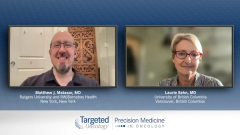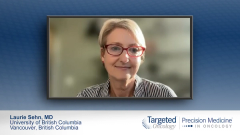
Follicular Lymphoma: Forecasting Bispecific Antibody Treatment Strategies
Closing out their discussion on bispecific antibody therapies, Matthew Matasar, MD and Laurie Sehn, MD, consider ongoing clinical trials and real-world use of these novel agents.
Episodes in this series

Transcript:
Matthew J. Matasar, MD: Having set this landscape with the pending availability, at least in the United States and, hopefully, Canada, of the bispecific antibody mosunetuzumab, then you have to ask the question, in a world where we have access to both CAR [chimeric antigen receptor T-cell therapy] and mosunetuzumab in the treatment of FL [follicular lymphoma], for me, the value proposition of bispecifics in follicular lymphoma is different than they are in large-cell lymphoma because of that question of cure that you so importantly invoked. We know that CAR T-cell therapies hold curative potential in the treatment of diffused large B-cell lymphoma. It’s not yet so clear that that is true, or if it is true, that it may not also be true with bispecifics. So when you’re dealing with treatments that don’t have that same ethical burden of offering treatment with curative potential and prioritizing it, for me, it allows a prioritization of bispecific antibodies with a preferred toxicity profile and outpatient management, easier access. We’re reserving the more toxic CAR T-cell therapy for patients who don’t respond adequately or relapse subsequently following bispecific antibody treatment.
Laurie Sehn, MD: I would fully agree. Clearly, we don’t have comparative data that compares them side by side to tell us which is preferred. I think what we’d love to learn is which patients, based on their unique biology, would preferentially benefit from a bispecific vs CAR T-cell therapy and how to sequence these 2 different approaches in individual patients. We’re not there yet, but it would be nice to think that with evolving biological insight, we might one day get a point where we can pick strategies based on biology.
In the absence of having that ability, we’re left weighing the 2 strategies based on what we understand their efficacy to be measured against their toxicities, resource intensity, inconvenience, and cost. And I would agree that right now, based on the weight of the data, it’s most likely that bispecific antibodies will jump ahead of CAR T-cell therapy for most patients because of the preferential ease of administration, toxicity profiles, and, at least for the time being, [a] lower risk of longer-term toxicities. It’ll be fascinating as we see the longer-term data from both CAR T-cell therapy and the bispecifics and understand more about the durability of benefit or the potential for curability. That would clearly sway where they may be weighted. But, for the time being, I think bispecifics will come out as preferentially utilized ahead of CAR T-cell therapy.
Matthew J. Matasar, MD: There’s clearly a lot we have left to learn about bispecifics and how best to leverage them in the treatment of our patients with follicular lymphoma, not just in terms of understanding the long-term properties of monotherapy, but also in what line of therapy [they’re] best deployed in, whether there are appropriate partners for building combination treatment programs to offer improved disease control. Are there ongoing studies that particularly have you excited for the future development of this class of drug?
Laurie Sehn, MD: Yes. Inevitably, we’re all excited based on the activity we’re seeing in the third-line setting and beyond, [thinking] about what drugs like the bispecifics [might] do in an earlier setting. We’ve got registration trials that are being planned in the second-line setting that are going to be randomized trials in which they’re combined with lenalidomide. For example, mosunetuzumab and lenalidomide is going to be compared against R2 (lenalidomide, rituximab) to see where it lines up. I think that given the modality of action of bispecifics, that it’s a type of immunotherapy, the idea of combining it with other immunotherapy approaches that might augment that modality is really enticing. This combination of mosunetuzumab and lenalidomide is shown to be quite effective in a phase 2 study that was reported, so it’s exciting to see that that’s going to be moving to a randomized comparison in the second-line setting. But there are many trials across the board looking at combinations of bispecifics with a variety of novel therapies in development. I think this makes for a very exciting time to figure out how we can leverage some of these very promising treatments by combining them with either existing treatments or other novel treatments that will either synergize or make the efficacy better across the board.
Matthew J. Matasar, MD: I really agree with you about the attractiveness of lenalidomide as a partner for these agents. We’re soon opening a multicenter study looking at mosunetuzumab in combination with lenalidomide and the anti-CD19 drug tafasitamab. Tafasitamab plus lenalidomide has been an approved combination treatment for relapsed, diffused large B-cell lymphoma. So we’re looking at this as a potential triplet in both aggressive and indolent lymphomas to see whether you can leverage that combination treatment further. You can’t co-administer CD20 antibodies like rituximab with mosunetuzumab because [of binding issues], but administering a CD19 antibody is feasible. We’ll see whether that triplet offers any additional promise. I’m also excited to see the first-line data for mosunetuzumab monotherapy. The idea that this class of drugs is active and well-tolerated enough to potentially supplant the standard immunotherapy approach for patients with newly diagnosed follicular lymphoma is very exciting.
Laurie Sehn, MD: Absolutely, and it’ll be probably some time before we see that data emerge. Until then, we are seeing data from single-arm trials of monotherapy with bispecifics, and this makes a very attractive alternative for the elderly or frail patient where chemoimmunotherapy has never been a particular attractive option. So I certainly look forward to more data emerging in that patient population and how these new options might be an alternative to what we currently have to offer.
Matthew J. Matasar, MD: Dr Sehn, you’ve painted a picture for us in the field of follicular lymphoma where we have established standards of care in the first-line setting despite this being a remarkably heterogenous disease. As patients experience subsequent relapses, that heterogeneity further complicates clinical decision-making. Despite that, we have a growing armamentarium of options both currently approved as well as emerging therapies, such as bispecific antibodies, that hopefully offer our patients more hope and give us as oncologists more options to individualize and personalize the care of our patients. So I share your enthusiasm and thank you for sharing your perspective and wisdom with us this evening.
Laurie Sehn, MD: Thank you. I think it’s a remarkably exciting time. This is one of many conversations I’m sure we’ll be having because there’s a lot of data emerging and treatment is changing, treatment options are increasing. It’s certainly adding to the complexity but also to the excitement, and certainly we expect that outcomes will be improving as well.
Matthew J. Matasar, MD: Well put. Thank you to our audience for watching this Targeted Oncology discussion. We hope that you found this discussion informative and valuable in the treatment of your patients with follicular lymphoma.
Transcript edited for clarity.












































